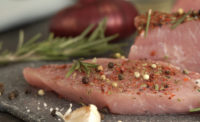Incorporating the optimal mixers and blenders in meat and poultry processing plants can be tricky.
As technologies evolve, operators can find it tough to pinpoint equipment that can produce the highest-quality products in the most cost-effective manner.
Because virtually any meat or poultry product other than whole-muscle cuts will require a degree of mixing or blending, leveraging effective systems is essential for efficient operations, says Joseph Sebranek, professor of agriculture and life science in the departments of Animal Science and Food Science and Human Nutrition at Iowa State University, in Ames.
“Mixing and blending of two or more meat materials with non-meat ingredients is a crucial step in processing to add value and variety to processed meat products,” he says. “Advancements in technology for lean-meat recovery from bone and connective tissue is providing processors with new sources of protein, which adds significant value to historically underutilized material” and is helping to drive innovation in mixing and blending equipment and procedures.
Likewise, demand in recent years for alternative, plant-based protein products also is contributing to equipment and process upgrades, Sebranek says.
While mixing and blending has historically been a major element in the development of small particle-sized products, such as hot dogs and cooked and fresh sausages, it is becoming more prominent in the processing of larger muscle pieces, including roast beef, turkey breast and ham, says Jeff Sindelar, associate professor and extension meat specialist in the Department of Animal Science at the University of Wisconsin, in Madison.
Mixing and blending ingredients vary by product, Sindelar says, and include the distribution of meat with other elements including spices and cheese. “A major function is to provide fresh product texture and yield through protein extraction,” he says.
Mixing includes mechanical action to extract salt-soluble proteins that hold products together for consumer acceptability and sliceability, says Jonathan Campbell, extension meat specialist and assistant professor of animal science in the Department of Animal Science at Penn State University in University Park.
A plethora of potential
In addition, mixing and blending is intended to create consistent, homogenous products, he says, noting processors can achieve good distribution of meat and non-meat ingredients through the addition of water or other liquids.
“Not all blenders and mixers have the same action, so suiting the equipment to the process is paramount for successful blending,” Campbell says.
Mixing and blending designs and configurations, meanwhile, are expanding and meshing with different technologies, he says. Those include equipment with vacuum lids; cryogenic chilling systems that use carbon dioxide and liquid nitrogen; and machinery intended to mix larger, smaller, high-fat or lo- fat ingredients, Campbell says.
Implementing the optimal configurations requires decisions on blending action (single versus double), mechanical designs (paddle versus ribbons) and rotation (forward only versus both forward and backward) for each product, along with sanitary design elements, Campbell says.
Other considerations, Sebranek says, are the design and shape of blending tanks and paddles to maximize the efficiency of the blend; the inclusion of programmable controls for setting time, speed and temperature; controls that offer real-time measurements of products during blending; the efficiency of built-in cooling systems, which can include carbon dioxide or nitrogen injection; cost of ownership; utility consumption; and the overall effectiveness of the equipment.
Education essential
Experience is perhaps the best way for meat and poultry processors to select the pertinent mixing and blending technologies, which includes understanding what is appropriate for the different raw materials and products, Sindelar says.
“It involves understanding the scientific nature of the chemistry and biology of the raw materials and the process itself,” he says.
Processors also should know the limitations of specific mixing and blending equipment, the impact improper mixing and blending technologies can have on product development and how to optimize mixing and blending for particular products, Sindelar says.
Information can come from textbooks, trusted online readings, technical bulletins or conversations with people “who understand the science and technologies of what is occurring,” he says.
Such sources may include equipment manufacturers who have the knowledge and expertise to “build upon the core principles and fundamentals and allow one to understand what the mixing and blending technology can do if it is a right fit, along with the advantages and limitations of specific technologies. It is not simple.”
The size and type of product under development, rather than species, should govern the choice of mixing and blending technologies, Sindelar says.
“Processors also need to consider product goals and then, going backwards, consider particulate size and composition of the proteins, including the amount of fat along with the ability of raw materials to withstand the unit’s mechanical energy,” he says.
Using inappropriate technologies can result in product failure, which may include a lack of bind, inferior texture and poor distribution of ingredients that compromises yields, uniformity and appearance, resulting in product waste, he adds.
Processors can achieve the best results by using mixing and blending equipment that is tailored to their particular applications, Sebranek says.
“Paddle-style blenders will be more effective than ribbon-style blenders, and vice versa, for specific products and to maximize efficiencies,” he says. “Mixing tank shape should also be a consideration. Given that the blend must be homogenous across the longest span of the tank, square tanks that limit the diagonal distance from corner to corner should be considered more efficient than rectangular tanks.”
In addition, operators should formulate batch sizes that are appropriate to the capacity of the equipment, Sebranek says, noting “over filling creates dead spots above the paddles that may create less homogenous blends. Use the equipment as intended by the design and utilize the technology that the equipment provides.”
New, not always necessary
While mixing and binding technologies are evolving, older equipment remains viable for many operations, Sindelar says.
“There are systems where newer technologies aren’t advantageous,” he says. They include “mixing fresh pork sausage, an area where there has not been very much change over the years.”
In contrast, adulterated turkey breast may benefit from a newer vacuum lidded system, which can help control and maintain temperatures and optimize protein extraction without damaging the structure of the tissue, Sindelar says.
Designs with computer controls that can better monitor such functions as speed, temperature, revolutions and direction also are becoming more prominent, he says.
Technologies that use computer-based calculations also enable processors to more easily determine such elements as the amount of fat, protein, beef, pork, poultry, water and ice they should add to mixers and blenders to create products in a specific weight and at optimal cost, says Norman Marriott, emeritus professor in the College of Agriculture and Life Sciences at Virginia Polytechnic Institute and State University (Virginia Tech) in Blacksburg.
“There are systems where newer technologies aren’t advantageous...”
--Jeff Sindelar, University of Wisconsin
For best results, it also is important for processors to add ingredients to the machinery gradually during production and for them to adhere to the proper mixing and blending times, he says.
“Products will not be uniform if operators do not mix long enough, while mixing too long can create temperature buildup which compromises texture and quality,” Marriott says.
“Simply mixing longer is not always the answer,” adds Bob Delmore, a professor in the Department of Animal Sciences at Colorado State University, in Fort Collins. “Sometimes we are using an undersized mixer or a mixer for the wrong application, and mixing longer results in an overworked product that is too firm.”
Processors, meanwhile, should work closely with technology suppliers to better pinpoint the most appropriate equipment for specific products and the optimal mixing processes, he says.
“Some processors believe they just need to ‘mix it’ and that is the end of the discussion,” Delmore says. “By teaming with manufacturers they can determine the correct equipment size. And once batch size is established, don’t deviate from the minimum or maximum weight in the mixer. Processors making changes to ingredients, raw material types and level of added water will likely need to adjust mixing times and the order of ingredients put into the mixer.”
Change is in the air
Changes to mixing and blending procedures will continue as processors alter their product lines, Marriott says.
“Processors should establish strict standard operating procedures for each process, use timers or have employees that keenly understand established manufacturing processes,” Delmore says.
Additional challenges facing processors seeking to enhance mixing and blending operations is identifying the optimal blending times for controlling temperature rise and protein extraction while maintaining product integrity, blend quality and the necessary throughput to keep downstream processes sufficiently supplied, Sebranek says.
He says processors can effectively handle such issues with production-line designs that maximize consistent throughput for each process, by ensuring there are blend protocols that cover the order and time of adding non-meat ingredients, from pre-blending similar ingredients, and by creating brine with water-soluble ingredients for water-added, injected and vacuum-massaged products.
Campbell, meanwhile, says ensuring foreign material does not penetrate the mixing and blending processes also is a key concern.
“Metal-on-metal contact may increase the risk of metal fragments entering the food if processors do not adhere to good preventive maintenance procedures and schedules,” he says, adding that the mechanical action of mixing also can add unwanted heat to products. Operators can help mitigate temperatures by adding ice or dry ice to mixers for both food safety and quality purposes, Campbell says.
The cost of implementing effective mixing and blending systems, along with understanding the benefits and limitations of the different technologies, are further issues facing meat and poultry processors, Sindelar says.
Because older facilities may have inadequate processing floor space or layouts that can prevent operators from installing the optimal technologies or the desirable amount of equipment, processors must weigh the pros and cons of investing in larger facilities or designs, which in some cases might offer “just a little bit more benefit,” he says.
Equipment costs can vary in accordance with the size and capacity of the mixes and blenders and level of sophistication, such the inclusion of vacuum lids that also remove air to enhance flavor and shelf life, Marriott adds.
But it is essential that decisions do not affect food quality, he says, adding that uneven blending of seasonings, for example, can create products that are either too spicy or lack flavor.
“Mixing and blending systems are key for the proper distribution of important ingredients and to prevent overmixing,” Delmore says. “But for large systems, a detailed discussion with the manufacturer and their technical services team is key to preventing mistakes.”





Report Abusive Comment